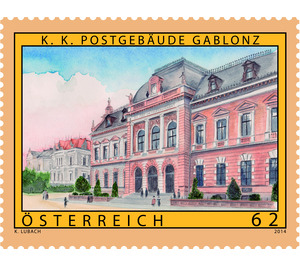Old Austria - Austria / II. Republic of Austria 2014 - 62 Euro Cent
Theme: History & Politics
| Country | Austria / II. Republic of Austria |
| Issue Date | 2014 |
| Face Value | 62.00 |
| Edition Issued | 360,000 |
| Printing Type | offset |
| Stamp Type | Commemorative |
| Item Type | Stamp |
| Chronological Issue Number | 2457 |
| Chronological Chapter | OOS-OE2 |
| SID | 987603 |
| In 59 Wishlists | |
The current special stamp from the brand series "Old Austria" honors the charming Bohemian town. Jablonec nad Nisou, in German Gablonz on the Neisse, is located at the foot of the picturesque Jizera Mountains. The historic center bears witness to the golden era of the former Habsburg glass jewelery town - splendid Art Nouveau villas line the often steep streets alongside imposing Baroque, Classicist and Renaissance buildings. Gablonz was first documented in 1356 - but the settlement disappeared again in 1469 due to an attack by the Bohemian King Jiří of Poděbrad. The first glassworks were built here in the mid-16th century, but the town burned down again in 1643 as part of the Thirty Years' War. Nevertheless, the abundance of wood, sand and water quickly revived glass production. In the 18th century, the first jewelery factory was opened and the "Iserberg glass" gained European recognition. In 1866, Emperor Franz Joseph I elevated the market town to a city that was to flourish. The range of glass and glass jewelery expanded steadily and was soon delivered to all parts of the world. The town subsequently developed into a significant one Business center. New roads and railway connections were created, and splendid buildings such as the Stadttheater, built according to the plans of the Viennese architects Fellner and Helmer, gave Gablonz a sophisticated cityscape. In 1918 the Danube monarchy disintegrated, and Gablonz belonged to the newly founded Czechoslovakia. The year 1938 marked a turning point for the flourishing glass business. Gablonz was annexed by the German Reich, many people had to flee or were deported. After the war, the city became part of the Czechoslovak state again. Most German-speaking residents were expelled from the country, but many of the displaced gathered in other cities, where they practiced their trade again - including in the Upper Austrian Enns, where the Gablonzer cooperative founded in 1947 has been selling fashion and silver jewelry worldwide for decades. Today, Jablonec, which is now part of the Czech Republic, is once again a city of jewelery and glass art, and for many visitors it is also an attractive starting point for excursions and sports activities in the Jizera Mountains. The motif of the brand "K. K. Postgebäude Gablonz "shows the local post office in a view from 1899. The building was built in the years 1892 to 1894 according to the plans of the architect and k. k. Oberbaurates Friedrich Setz, under whose leadership a total of 26 post and telegraph offices were established in the monarchy. The "Postovni Urad" was renovated a few years ago and now serves as the city's main post office.


